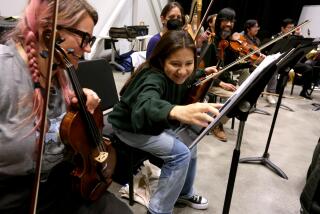MUSIC REVIEW : VIOLINIST SZERYNG AT AMBASSADOR
Henryk Szeryng does it his way.
The Polish violinist neither grandstands, nor intellectualizes, nor manipulates his audience, nor indulges any tricks of the virtuosoâs trade. He simply makes music and, in the process, produces some of the most gorgeous sounds this side of heaven.
Partly because he belongs to the no-fuss school, the crowd he attracted to his recital Wednesday at Ambassador Auditorium, Pasadena, fell predictably below capacity. More telling, however, was the high number of professional fiddlers who turned out for the event.
They knew what they came for, and Szeryng delivered. Sane and savory demonstrations of the sort he gave are not your everyday happenings.
Szeryng does not clench his eyes shut or wrinkle his brow or wear any expression, really, other than a placid one. Furthermore, he stands in a single spot, feet together and perfectly upright, neither veering nor lurching with the tides of physical effort. Could anything possibly be so simple?
Apart from a few screechy bars in the E-minor Bach Sonata, BWV 1023, with which he opened the program, Szeryng was in pristine form. The pleasing firmness of his bowing stops short of stress, yet is virile. The full-bodied tone is refined but still robust. The natural, musical flow entices the ear. The combination makes for an extravagance of beauty.
The violinist, aptly accompanied by pianist Charles Reiner, did not contradict this impression over the course of his program that included Brahmsâ Sonata in G and two Hungarian Dances, Debussyâs Sonata, Ravelâs âTziganeâ and Jualian Carrilloâs âPreludio.â He even managed to issue specific sounds to complement each composer.
For the Brahms, it was a rich, glinting liquid with plenty of sweetness for the upper string and a big heaping of deep voiced earthiness for the Dances. For Debussy, it was an oblique, muted, shadowy thing that contrasted the limpid/turbulent and wistful/agitated facets of the score.
For neither composer was there an example of deep probing, however; Szeryng leaves such work to his more intellectual colleagues. Even the contemporary piece by Carrillo, which the violinist included as a tribute to his Mexican citizenship, was not particularly thorny.
More to Read
The biggest entertainment stories
Get our big stories about Hollywood, film, television, music, arts, culture and more right in your inbox as soon as they publish.
You may occasionally receive promotional content from the Los Angeles Times.










